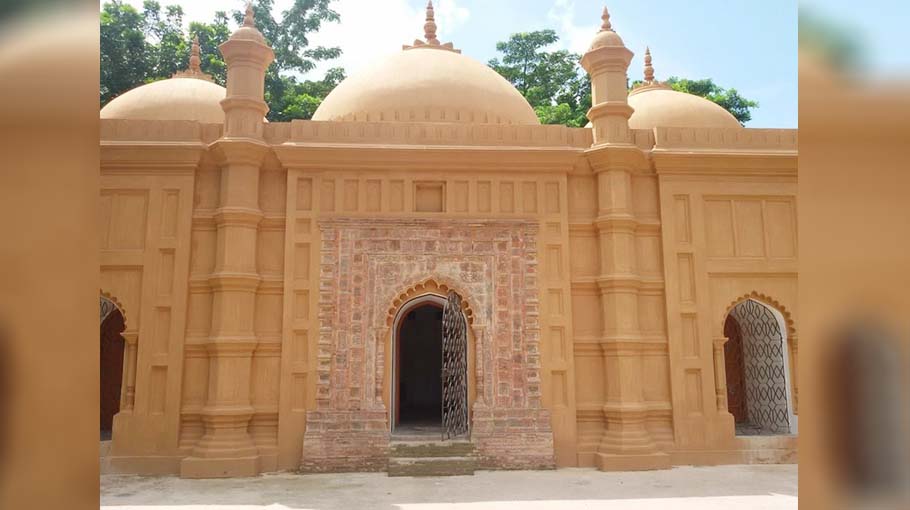Terracotta Mosque, a heritage of Gournadi

Historical three domed teracotta mosque situated in Kamlapur village under Khanjapur union under Gournadi upazila of Barishal is a unique example of artistry and style of terracotta art of the Sultani region.
Under the supervision of the Department of Archeology, Kamlapur terracotta mosque is thought to be built during the last leg of the 17th century. The mosque is 17.22 metres (56 feet) in length and 8.8 metres (26 feet) in width. Its walls are 1.83 metres (6 feet) thick.
There are five entrances of the mosque- three are on the east side and two each are on the southern and the northern walls. The entrances through the walls are decorated with multiple inscribed columns.
The main entrance on the east side is larger than two other entrances.
Three semi-octagonal Mihrab standing in front of the Kiblah of the mosque also bears an exquisite artistic heritage of the Sultani era. The Mihrab at the middle is extended westward accompanied by two small octagonal towers or minarets.
This terracotta built mosque has been divided into three parts with arches. Each part contains a small, conical shaped dome. However, the central dome of the mosque is larger than two other domes. The tops of the domes are decorated with the design of lotus and the pitcher.
The Sultani aged terracotta decoration marks the characteristics of the mosque. The intricate terracotta motifs with floral designs rose designs and net designs on the walls of the entrances enchant the devotees and the visitors for age. Specially, the beauty of multiple inscribed designs of the Mihrab is incomparable.
There is a spacious sitting arrangement infront of the mosque.
Caretaker of the mosque Syed Sumon Ahmed informed it was not possible to determine the exact date of construction of the mosque following the stealing of the Foundation Stone from the entrance of the mosque but according to the estimate of the Department of Archeology, the mosque was built during the last phase of the 17th Century.
Local resident Emdad Hossain Howlader informed the Department of Archeology included the mosque as a heritage in 1975. Later on, the mosque was renovated and repaired several times. He further mentioned, the designs of pitchers on the dome of the mosque have recently been damaged due to storm that is why it should be repaired immediately. He further informed a staff from the Department of Archology was deputed here to take care of the mosque but he seldom attends his duty.
Recently, a Madrasha has been set up beside the mosque and now the students and teachers of the madrasa regularly take care of the mosque.
In addition to an ablution tank, a foreign organisation has set up an ablution arrangement for the devotees.
Inspite of arranging prayers five times a day, all necessary religious functions are arranged and regular Iftar is also arranged at the mosque during the month of Ramadan for a long time. At a time nearly 300 devotees can say their prayers in and outside the mosque. Many people from various districts of the country visit the mosque regularly to watch its terracotta beauty and to say their prayers.
Locals however demanded immediate repairing of the roads connecting the mosque.



